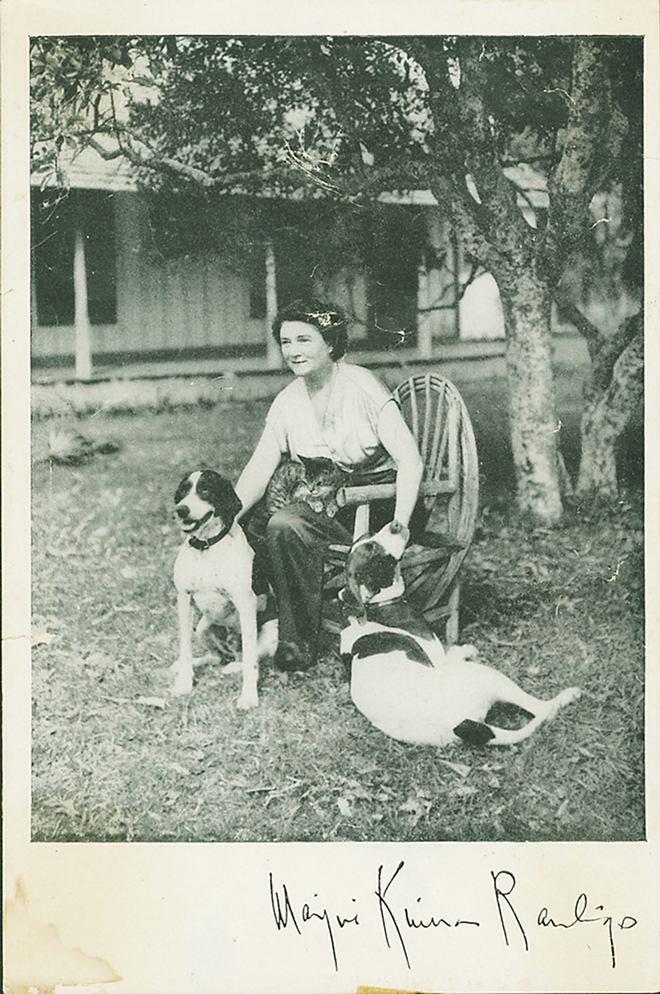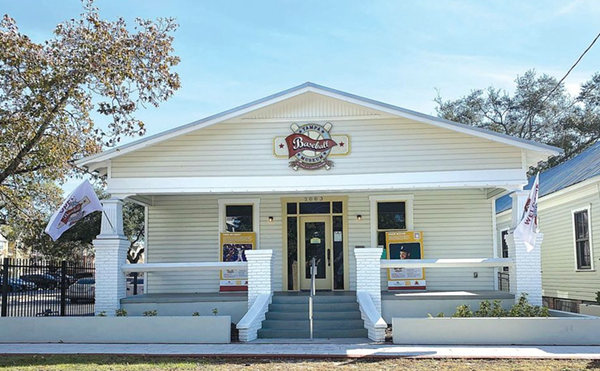
“Wash the decapitated gopher. Cut the shell away from the meat. Scald the feet until the skin and claws can be removed. Discard entrails.”
In this passage from Cross Creek Cookery, Marjorie Kinnan Rawlings isn’t talking about those fuzzy little rodents that burrow in the ground. She’s talking about the gopher tortoise, which she uses in making the old St. Augustine favorite Minorcan Gopher Stew (before killing tortoises became illegal). And you’d better believe that she decapitated that tortoise herself, probably only a few feet from her home south of Gainesville and north of Ocala.
In the chapter on Florida seafood, Rawlings recounts getting electrocuted while trying to catch flounder bare-handed. After getting an unexpected shock trying to grab the largest flounder she saw (“Nobody had told me flounders were dangerous…”), she used her rubber bathing cap as an insulator against electricity, caught several fish and took them home to fry in cornmeal and serve alongside grits. She was later embarrassed to learn that the fish she’d caught weren’t flounder but electric rays (which look similar to flounder, lying flat on the ocean floor).
“No self-respecting starving dog has ever been known to eat them,” Rawlings wrote.
That self-deprecating humor is part of what makes her writing so charming; she shares stories of her cooking and hunting mishaps alongside her successes. Rather than talking down to the reader, as so many cookbooks do, Rawlings is a down-home gourmand, armed with shotgun, knife, skillet and typewriter.
“Some of my dishes may horrify the delicate, who may consider them… unblessed,” Rawlings wrote. “I have included nothing that is not extremely palatable, and the reader or student of culinary arts may either believe me or fall back in cowardly safety on a standard cook book.”
Cross Creek Cookery is certainly not a standard cookbook, but it remains a go-to volume on my kitchen shelf. The recipes derive from foods mentioned in Rawlings’ memoir Cross Creek, in which she detailed her life in Cross Creek, Florida. The descriptions of food in the memoir drew such an enthusiastic response from readers (especially soldiers) that she was prompted to create the cookbook, which was published in 1942.
Rawlings, who won a Pulitzer Prize for her novel The Yearling, moved to Florida when she was 32 and fell in love with its wild landscape.
“A great many of these recipes are based on native Florida ingredients,” she wrote. “It has been my pleasure to experiment with them, and to hang tenderly over the shoulders of Florida backwoods cooks, often sportsmen, when engaged in stirring up a dish new to me.”
Crabs, specifically prepared à la Newburg, were one of her treasured dishes. She would go out at night to nearby freshwater springs and trap fresh blue crabs for an upcoming feast.
“We hunt them by night, drifting slowly downstream in a rowboat with flashlight and long handled crab-claws that clamp shut when they strike the crab, spotted through the deep clear water by our light. We take no more than we shall use.”
Unlike some of the exotic ingredients called for in today’s cookbooks, you’ll find Rawlings’ recipes to be made up mostly of commonly available staples (though today’s chefs are less inclined to use now-illegal meats like turtle, bear and blackbird). But one ingredient from the book cannot be found anywhere, unfortunately: the milk from Rawlings’ beloved New Jersey dairy cow Dora, whom she describes as somewhat of a national treasure.
“I sometimes think that, as the supreme sacrifice, I might give Dora to my country. She is irreplaceable… when Dora is gone, God rest her wicked soul… I think I shall not make or eat ice cream again for there is no substitute for perfection.”
Rawlings also introduced many outside the South to collard green etiquette.
“Corn bread is always served with collard greens and it is etiquette to dunk the cornbread in the pot liquor” — pot liquor being the rich broth left after cooking collard greens in bacon and water.
Rawlings’ collection of jelly, marmalade, and preserve recipes is a cornucopia of exotic and unexpected flavors — loquat chutney, kumquat marmalade, and wild blackberry jelly, to name a few.
Rich foods were “company” dishes, served only when guests were dining at Cross Creek. Her secret to a successful gathering was that the food be prepared willingly and with imagination: do it with a smile or don’t do it all.
“Food imaginatively and lovingly prepared, and eaten in good company, warms the being with something more than the mere intake of calories.”
Her father’s grace, spoken at dinnertime each night, summed up her feelings on food and dining together. “Receive our thanks, heavenly father, for these mercies. Bless them to our bodies’ good, for thy name’s sake. Amen.”
















